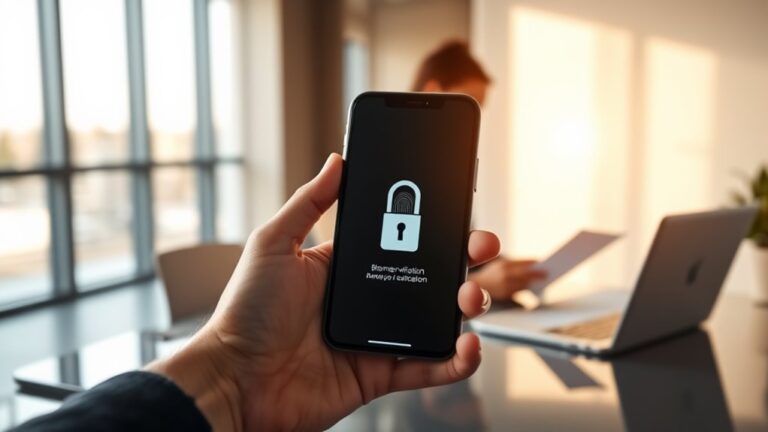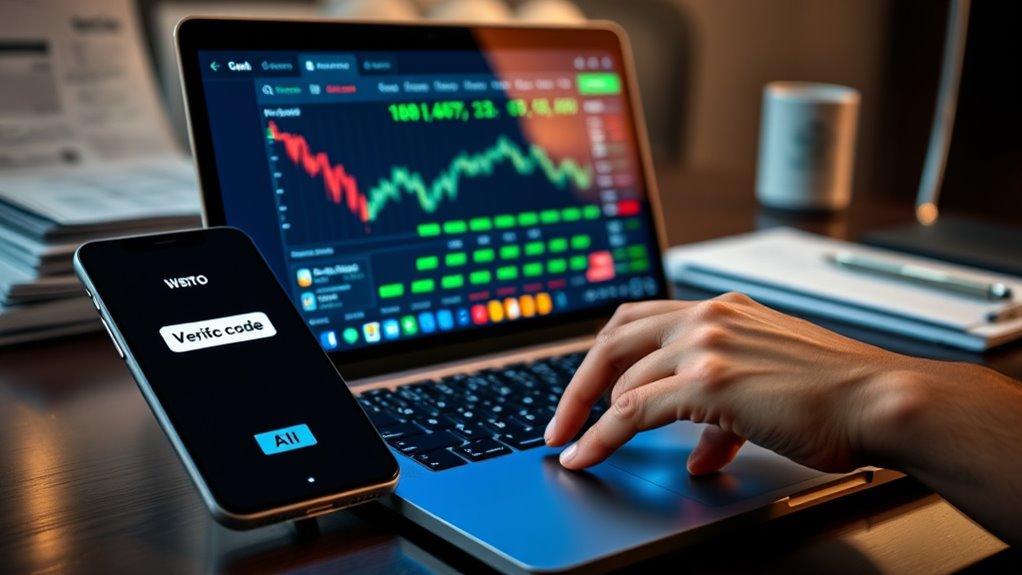
How to Sign Up and Verify Your Account: A Step-by-Step Guide to Crypto Exchanges
To sign up for a crypto exchange, users should first select a reputable platform with strong security features. They create a unique email and strong password, complete verification procedures, and implement multi-factor authentication. The KYC process requires submitting government-issued ID and proof of address through clear, well-lit images. Payment methods like bank transfers or credit cards can be linked after verification. Common issues include poor image quality and information mismatches. The following guide provides additional details for troubleshooting verification problems.
Key Takeaways
- Choose a reputable crypto exchange with strong security features, positive reviews, and regulatory compliance before signing up.
- Create a unique email address and strong password, then complete email verification to establish your account.
- Implement multi-factor authentication immediately after account creation to enhance security protection.
- Submit clear, well-lit images of government ID and proof of address that match your personal information.
- Link preferred payment methods like bank transfers or credit cards after completing KYC verification requirements.
Choosing the Right Crypto Exchange Platform

When beginning a cryptocurrency journey, selecting an appropriate exchange platform becomes a vital first step for investors. Several factors should guide this decision, including the platform’s security features, regulatory compliance, and insurance policies to protect digital assets from potential breaches.
Users should compare available cryptocurrencies across exchanges, as offerings range from Bitmart’s extensive selection of over 1,700 cryptocurrencies to Gemini’s more limited catalog of about 70.
Cryptocurrency selection varies dramatically between platforms, affecting investment possibilities for both novice and experienced traders.
Trading fees, interface usability, and customer support quality also vary greatly between platforms. Beginners might prefer user-friendly exchanges like Coinbase, which offers educational resources, while experienced traders may gravitate toward advanced platforms like Kraken Pro with sophisticated trading tools.
Payment options represent another essential consideration, with exchanges differing in their support for bank transfers, card deposits, and minimum deposit requirements. Additionally, it’s crucial to evaluate the exchange’s security features to ensure a safe trading experience.
Creating Your Initial Account Credentials

Selecting reputable crypto exchanges with strong security measures forms the foundation of a safe cryptocurrency journey.
After choosing a platform, users must create secure account credentials, including a unique email address and a strong password containing a mix of letters, numbers, and special characters.
The initial setup typically involves email verification and agreement to the platform’s terms of service, establishing the first layer of account security before proceeding to identity verification steps. Additionally, implementing multi-factor authentication can significantly enhance the security of your account.
Choose Trusted Exchanges
Several critical factors must be considered when creating your initial account with a cryptocurrency exchange. Reputation, regulatory compliance, and security features are paramount in selecting a trustworthy platform.
Established exchanges like Coinbase, Kraken, and Binance.US have strong security records and adhere to KYC procedures, which help combat fraud. Users should prioritize platforms that utilize cold storage and two-factor authentication to protect assets.
When evaluating exchanges, consider their cryptocurrency offerings, fee structures, and available payment methods. For instance, Coinbase supports over 200 cryptocurrencies, while Kraken charges fees between 0% and 0.4%.
Additionally, look for exchanges with high trust scores, positive user reviews, and transparent operations. Many reputable platforms undergo third-party audits and provide reserve data to establish credibility. Furthermore, ensure that the exchange you choose has a high level of security measures to protect your investments from potential threats.
Create Strong Credentials
The foundation of cryptocurrency account security begins with robust credential creation. Users should develop passwords that are at least 12 characters long, incorporating a mix of uppercase and lowercase letters, numbers, and special characters. Avoiding predictable information like birthdays or names is essential for maintaining security.
A password manager serves as an invaluable tool for generating and storing unique, complex passwords for each cryptocurrency platform. Additionally, enabling two-factor authentication provides a critical second layer of protection, preferably using authenticator apps rather than SMS verification.
Users should verify their email addresses immediately after account creation and use secure, unique email addresses specifically for crypto accounts. Implementing strong passwords with two-factor authentication helps significantly enhance account security against potential threats.
Regular monitoring of account activity helps detect unauthorized access, while keeping all associated software updated prevents exploitation of security vulnerabilities.
Navigating Email and SMS Verification Steps

After creating initial credentials, most platforms implement a multi-step verification process to guarantee account security.
Users typically receive verification links via email that must be accessed within a specific timeframe before expiration, while SMS verification codes provide an additional layer of protection through two-factor authentication.
Understanding proper verification code handling, including not sharing codes with others and immediately reporting suspicious verification requests, forms an essential component of maintaining account security. Implementing strong verification processes is vital for complying with KYC regulations, which help safeguard crypto transactions.
Securing Verification Links
Verification links serve as digital gateways to account security, requiring careful navigation through both email and SMS confirmation processes. These links employ strong encryption to protect user data and typically remain valid for a limited time period, necessitating prompt action.
Reputable exchanges never request sensitive information through verification links. Instead, they focus on confirming account ownership through secure channels. Users should exercise caution when clicking any verification link, ensuring it originates from a legitimate source.
For enhanced protection, many platforms implement two-factor authentication alongside verification links. This creates a multi-layered security approach that considerably reduces unauthorized access attempts. Additionally, users should consider using secure wallets to further enhance the safety of their crypto assets.
If verification issues arise, exchanges generally provide dedicated support resources to assist users through the process while maintaining compliance with regulatory standards.
Authentication Code Best Practices
Maneuvering the digital verification landscape requires understanding proper authentication code protocols for maximum security. When receiving verification codes via email or SMS, users should check that messages come from legitimate sources and never share these codes with others.
| Security Feature | Purpose | Implementation |
|---|---|---|
| Time-Limited Codes | Prevents delayed attacks | Codes expire after 5-10 minutes |
| Complex Composition | Reduces guessability | Mix of numbers and letters |
| Delivery Method | Guarantees proper receipt | Email for account setup, SMS for transactions |
Most cryptocurrency exchanges implement two-factor authentication (2FA) as an additional security layer. Users should enable this feature immediately after account creation. Remember that legitimate platforms never ask for verification codes through social media, phone calls, or unsolicited emails—any such requests are likely phishing attempts. Understanding the methods and patterns surrounding security breaches can further enhance your protective measures against potential attacks.
Two-Factor Setup Essentials
Two-factor authentication represents the cornerstone of account security in cryptocurrency platforms. Users typically have several options for implementing 2FA, with SMS and email verification being the most accessible starting points.
To set up SMS verification, users must provide their phone number to receive one-time codes for login attempts. Email verification works similarly, sending authentication codes to the user’s registered email address.
While convenient, both methods face security limitations, as messages can potentially be intercepted.
For enhanced security, authenticator apps like Google Authenticator or Authy generate time-sensitive codes directly on the user’s device. Setting up these apps requires scanning a QR code provided by the platform. Crypto wallets, which store private and public keys, are essential for managing access during these transactions.
Hardware tokens and biometric verification offer the highest level of protection, though they may require additional equipment or compatible devices.
Understanding KYC Requirements Across Exchanges
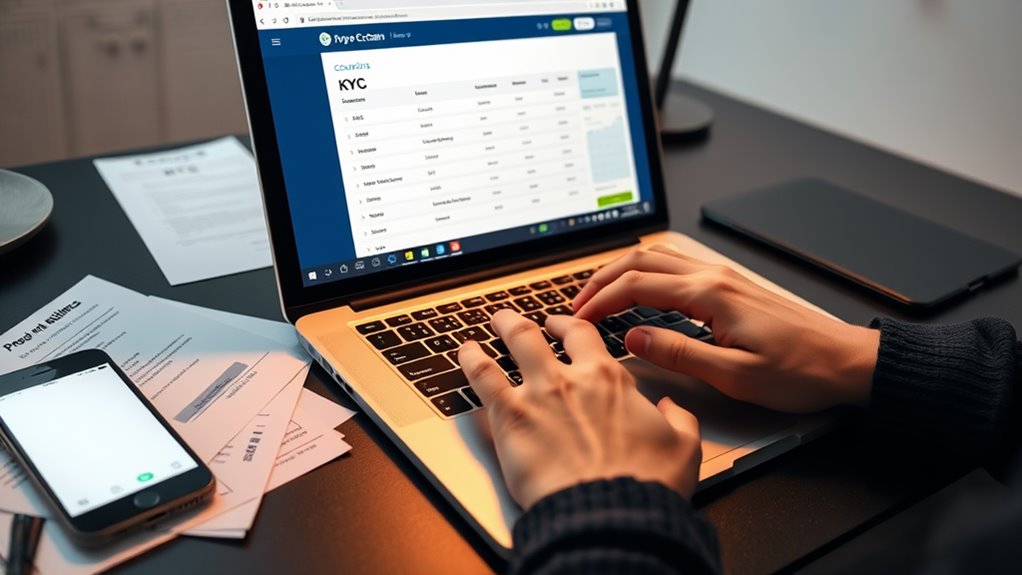
When diving into cryptocurrency trading, users quickly encounter Know Your Customer (KYC) requirements that vary considerably between exchanges. These verification processes are mandated by regulations to prevent money laundering and illicit activities.
The standard KYC procedure involves submitting personal information (name, address, date of birth), government-issued identification documents, and proof of address such as utility bills. Some platforms may require additional verification steps, including selfies or video identification for enhanced security.
While potentially cumbersome, robust KYC procedures offer significant benefits—they increase platform security, build user trust, and guarantee regulatory compliance. Exchanges implementing thorough verification processes protect not only their reputation but also contribute to the overall integrity of the cryptocurrency ecosystem.
Understanding these requirements beforehand helps users prepare necessary documentation and complete verification efficiently.
Uploading Identity Verification Documents

The verification process continues with the essential step of uploading identity documents to crypto exchanges. Users typically need to provide government-issued photo identification such as passports, driver’s licenses, or national ID cards, along with proof of address documents like utility bills or bank statements.
When uploading documents, users should guarantee images are clear, well-lit, and show all corners of the document. Most exchanges require that documents be current and unaltered. Some platforms also implement facial verification or liveness detection as an additional security measure. Additionally, successful identity verification is crucial for cryptocurrency deposits and withdrawals, as it ensures compliance with regulatory standards.
Users experiencing difficulties during the upload process should check their device compatibility and internet connection. Documents that are blurry, partially visible, or expired will likely be rejected, requiring resubmission.
Most exchanges provide troubleshooting guides to help users navigate common verification issues.
Setting Up Two-Factor Authentication for Enhanced Security

Securing cryptocurrency accounts requires implementing robust protective measures beyond basic passwords.
Two-factor authentication (2FA) adds an essential layer of security by requiring two distinct forms of verification before granting access to an account. Most major cryptocurrency exchanges, including Binance, Coinbase, and Kraken, support 2FA functionality.
- Choose a 2FA method – Select from options like authenticator apps (recommended for highest security), SMS codes, email verification, or hardware tokens based on your security needs.
- Complete the setup process – Typically involves scanning a QR code with your chosen authenticator app and confirming the connection.
- Create backups – Store recovery codes or backup keys in a secure location to prevent permanent account lockout if you lose access to your authentication device. Implementing 2FA is a fundamental step in enhancing user account security, which is critical for maintaining trust in cryptocurrency exchanges.
Linking Payment Methods to Your Crypto Account
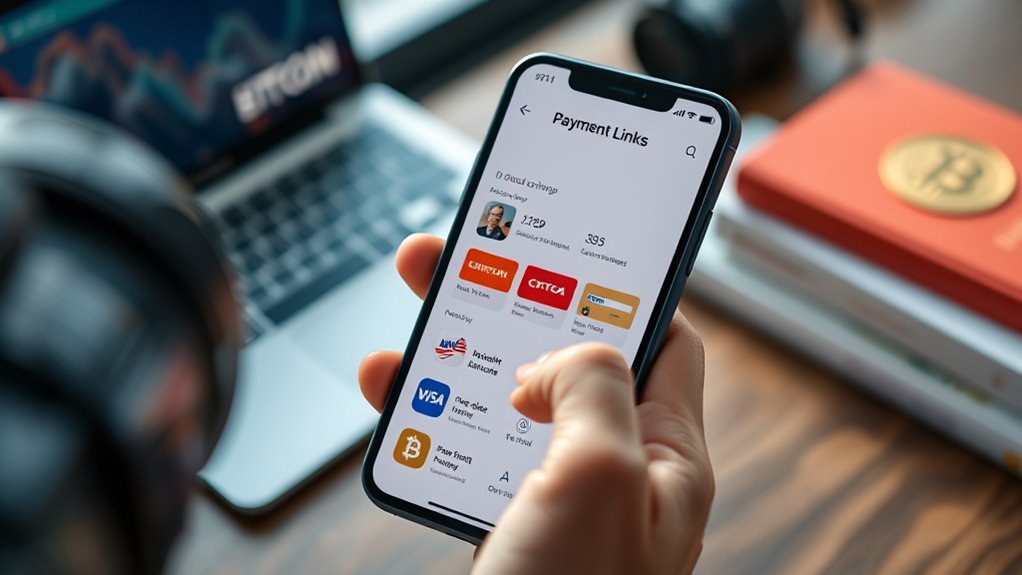
Successfully traversing the cryptocurrency landscape requires connecting reliable payment methods to your account. Most exchanges offer several options for funding, each with distinct advantages.
Bank transfers provide cost-effective solutions for larger deposits, while credit cards offer immediate access to crypto assets despite higher fees. E-wallets present another convenient alternative for many users.
Before linking payment methods, users must complete KYC verification to comply with regulatory requirements. The process typically involves maneuvering to the deposit section of the platform dashboard, selecting a preferred payment method, and following prompts to connect accounts or cards.
When choosing between options, users should consider transaction speeds, associated fees, and personal security preferences.
Most platforms integrate with established payment processors, offering seamless API connections that maintain security through robust encryption protocols.
Verifying Your Residential Address Information

Verifying residential address information represents a fundamental step in the account setup process, following the linking of payment methods.
Exchanges require address verification to comply with KYC and AML regulations, ensuring platform security while meeting regional compliance standards.
Address verification fulfills KYC/AML requirements, maintaining security standards while satisfying diverse regulatory frameworks across jurisdictions.
Users must submit documents that meet specific criteria:
- Acceptable documents include utility bills, bank statements, and government-issued documents issued within the last three to six months.
- Documents must clearly display the account holder’s name, full address, date of issue, and issuer’s name.
- Images should capture the entire document with high clarity, while sensitive information like account numbers may be masked.
If verification issues arise, users can typically resubmit documents or contact platform support for assistance through available channels.
Completing Biometric Verification Procedures

Biometric verification represents a critical step in the account setup process, leveraging unique physical characteristics to confirm user identities with unprecedented accuracy. Most platforms implement facial recognition technology that requires users to take a clear photo of their face, which is then compared to their identification documents.
During this process, users may be prompted to complete liveness detection checks, such as blinking, nodding, or turning their head to prove they are physically present and not using pre-recorded videos or photos.
These advanced security measures help prevent fraud while ensuring compliance with KYC and AML regulations. Technologies like iProov facilitate seamless verification experiences across devices without requiring re-enrollment, streamlining the user experience while maintaining robust security standards.
Troubleshooting Common Account Verification Issues
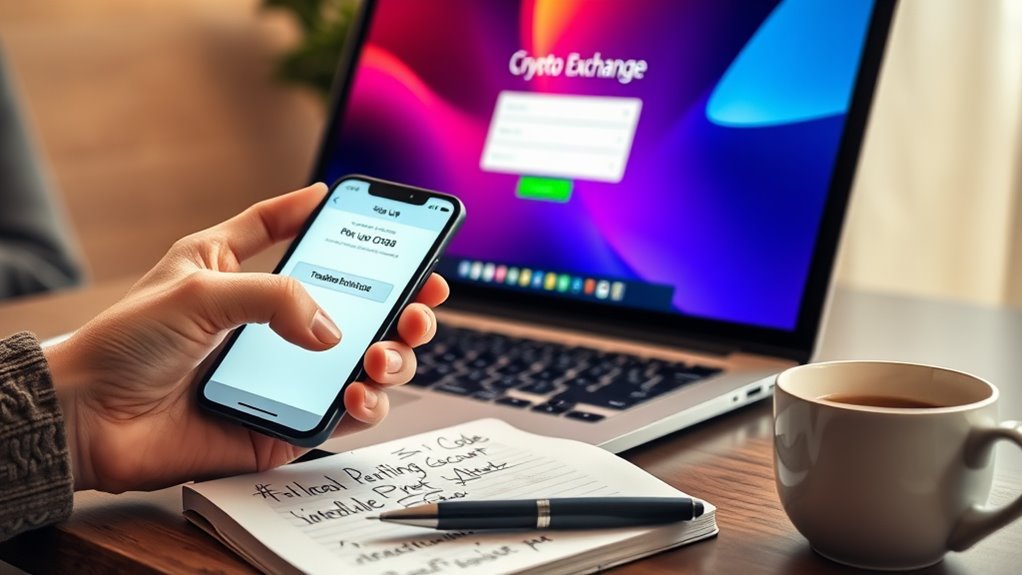
Account verification processes sometimes encounter obstacles that require troubleshooting steps to resolve.
Document upload errors often stem from poor image quality, incorrect document types, or outdated address proofs, which can be fixed by carefully adhering to specified requirements.
When identity mismatches occur or verification delays extend beyond normal processing times, users should contact support teams with relevant details, ensuring all submission information matches exactly across platforms.
Verification Delays Solutions
Facing delays during the account verification process can be frustrating for users keen to begin trading or using platform services. Exchanges are implementing various solutions to address these bottlenecks and improve user experience.
- Prepare high-quality documents – Submit clear, well-lit photos of your identification documents with all information clearly visible to prevent automatic rejections due to poor image quality.
- Double-check information accuracy – Verify all personal details match across submitted documents and application forms to avoid discrepancies that trigger manual reviews.
- Utilize automated verification options – When available, choose AI-powered verification methods like biometric facial recognition, which can process your information more quickly than traditional manual review systems.
Most exchanges now provide status updates throughout the verification process, allowing users to track progress and respond promptly to any additional information requests.
Document Upload Errors
Maneuvering the document upload process can present significant challenges during account verification, with numerous users encountering errors that delay their onboarding experience.
These issues often stem from format incompatibility, insufficient information, or outdated file versions.
Common errors include attempting to upload unsupported file types, selecting incorrect documents (such as order histories instead of transaction records), or using files that exchanges have recently revised.
Additionally, files that have been modified after download may be rejected during the verification process.
To troubleshoot these issues, users should verify the file type and source, consult platform-specific guidelines for supported formats, and always upload original, unmodified files.
When problems persist, contacting the platform’s support team is recommended, as they can provide guidance tailored to specific upload requirements.
Identity Mismatch Fixes
Many users encounter identity mismatch issues during the verification process, which can considerably delay account approval and platform access.
When verification systems detect discrepancies between submitted documents and account information, users must take specific steps to resolve these inconsistencies.
- Compare information carefully – Confirm all personal details (name, birth date, address) on your account precisely match those on your government-issued ID.
- Update account details immediately – If discrepancies exist, modify your account information through the platform’s profile settings before reinitiating verification.
- Use current, official documentation – Submit only valid, unexpired government IDs that clearly display all required information and follow proper formatting guidelines for dates and addresses according to the platform’s specifications.
Frequently Asked Questions
How Long Does the Entire Verification Process Typically Take?
Verification processes typically range from instant to five days depending on the level required. Standard verifications take a few hours to days, with timeframes influenced by application volume and documentation accuracy.
Can I Trade Cryptocurrencies While My Verification Is Pending?
Most exchanges allow limited trading while verification is pending. Users can typically make deposits and execute basic trades, but with restricted amounts and withdrawal capabilities until full KYC approval is obtained.
Are Verification Requirements Different for Institutional Versus Individual Accounts?
Institutional accounts typically face more stringent verification requirements than individual accounts, including enhanced documentation of legal status, governance structures, and authorized signatories, along with more thorough due diligence and monitoring processes.
What Happens if I Move to a Different Country?
When relocating internationally, users may need to update their address, resubmit verification documents, and comply with new regional regulations. Exchanges typically require notification of residence changes to maintain account compliance with local jurisdictional requirements.
How Often Do I Need to Reverify My Identity?
Re-verification frequency depends on the exchange’s policies and risk assessment. Users typically need to reverify when significant changes occur in personal information, location, or transaction patterns, or when regulatory requirements mandate periodic updates.
Conclusion
The theory that crypto exchange verification is complex proves true. While requirements vary, all exchanges prioritize security and regulatory compliance. By carefully following each step—from account creation to identity verification—users can successfully navigate the process. Though initial setup may seem overwhelming, completed verification grants full trading capabilities and account protection, making the effort worthwhile for serious cryptocurrency investors.







